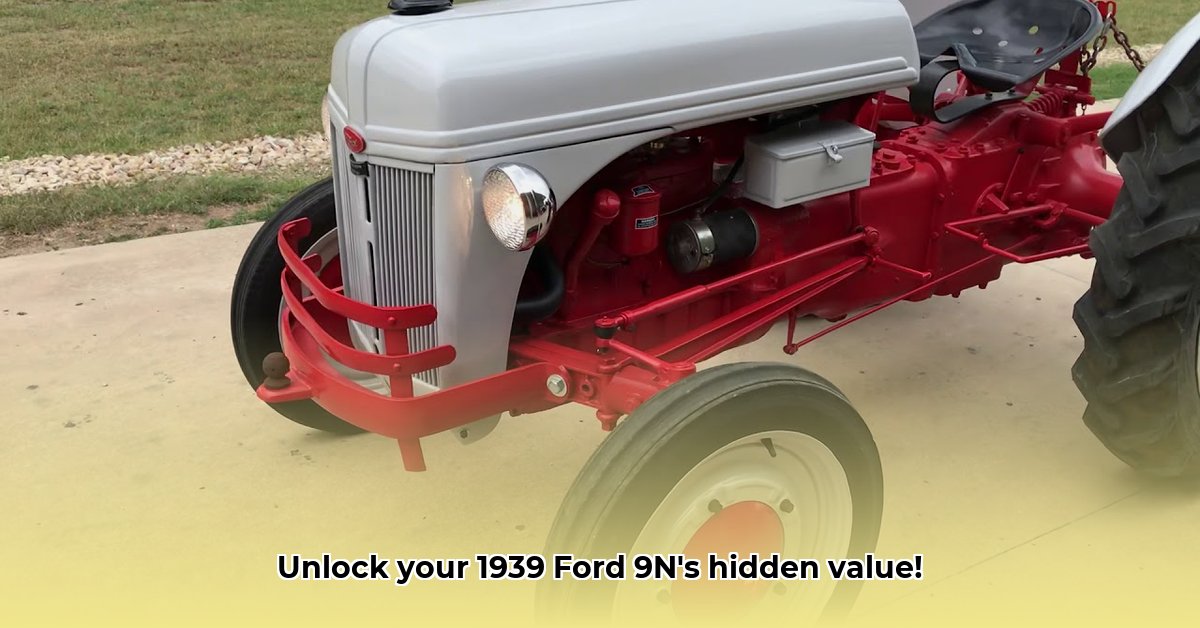
Finding the true value of a 1939 Ford 9N tractor isn't a simple online search. The price can fluctuate wildly, depending on condition, included accessories, and even geographic location. This comprehensive guide will equip you with the knowledge to confidently assess and negotiate the value of your Ford 9N, whether you're buying, selling, or simply curious. For more detail on engine identification, see engine codes.
Assessing Condition: A Visual Guide to Value
The condition of your Ford 9N is the most significant factor influencing its value. A meticulously maintained tractor will fetch a much higher price than one in need of restoration. We categorize condition into four levels, each with a distinct impact on value:
Excellent: This tractor is in near-pristine condition, appearing almost as-new. It's minimally used, entirely original, and functions flawlessly. These are rare finds commanding premium prices.
Good: Mechanically sound and dependable, this tractor displays minor cosmetic wear. Surface rust, faded paint, or minor blemishes might be present, but the tractor functions well. Small repairs may be needed.
Fair: This tractor shows significant wear and tear. It will likely require mechanical work and may have considerable bodywork damage. Restoration is feasible but will require significant effort and expense.
Poor: A "project" tractor, it's likely missing parts and has major mechanical issues. Complete restoration is necessary.
(Insert high-quality images here showing examples of tractors in each condition category. Include close-ups of key areas like the engine, bodywork, and tires.) A picture is worth a thousand words, especially when assessing a classic tractor's condition; visual details reveal much about its value. Don't just look at the surface; carefully examine each component.
Identifying Key Features: Beyond the Basics
Beyond overall condition, specific features significantly impact a 1939 Ford 9N's value. These details can substantially increase or decrease its worth.
Serial Number: The serial number, typically stamped on the engine or transmission, offers a glimpse into the tractor's history. A verifiable serial number enhances authenticity and value. (See this resource for assistance in decoding the serial number.)
Accessories: Included accessories, such as a front-end loader or original implements (plows, cultivators), significantly boost value. These attachments are often difficult to find in good condition.
Originality: Original, unrestored tractors are highly sought after by collectors. A tractor retaining its original paint, engine, and parts commands a higher price. Significant modifications can detract from value unless those modifications are highly desirable and professionally executed.
(Insert images here showcasing desirable accessories and a comparison of an original and a heavily modified tractor.) The presence of original, well-maintained accessories can significantly impact the value of the tractor.
Market Research: Understanding the Landscape
Thorough market research is crucial before making any buying or selling decisions. Online marketplaces specializing in vintage tractors, auction websites, and even classified ads are valuable resources.
Effective Searching: Utilize advanced search filters on websites like TractorHouse to refine your search by condition, included accessories, and geographic location. Precise filtering is key to finding comparable listings.
Analyzing Listings: Carefully examine sellers' descriptions and photographs. Detailed descriptions and high-quality images are indicators of a trustworthy listing. Be wary of vague descriptions or incomplete information.
Geographical Influence: Prices can vary significantly by region due to supply and demand. A tractor may command a higher price in areas with a higher concentration of collectors or greater demand. Analyzing regional trends is important.
Have you considered how regional differences might affect the price of your 1939 Ford 9N? This is a key factor in determining its true market value.
Pricing Strategies: Negotiating with Confidence
The price range for a 1939 Ford 9N is extremely broad, extending from a few thousand dollars for restoration projects to tens of thousands for pristine show-ready examples. Condition is the primary determinant, but accessories and location also play a role.
Restoration Projects: Tractors requiring complete restoration have lower value, ranging from several thousand dollars upward, depending on the extent of the repairs needed.
Show-Ready Tractors: Exceptionally well-preserved, mechanically sound tractors in excellent condition command significantly higher prices, potentially reaching tens of thousands of dollars.
Negotiation: Always negotiate politely but firmly. Your research will provide a solid foundation for determining a fair price and avoiding overpayment. Knowledge is power in negotiations.
The following table illustrates approximate price ranges in US Dollars (USD). These are estimates, and actual prices will vary based on the tractor's specific condition and location.
| Condition | US Price Range (USD) (Estimate) | Notes |
|---|---|---|
| Poor | $1,000 - $4,000 | Requires substantial restoration |
| Fair | $3,000 - $7,000 | Needs mechanical and possibly cosmetic work |
| Good | $6,000 - $12,000 | Mechanically sound, minor cosmetic issues |
| Excellent | $12,000+ | Pristine, highly original, potentially rare |
Beyond Monetary Value: The Intangibles
The value of a 1939 Ford 9N extends beyond its monetary worth. Factors such as rarity, model year, and historical context can influence its desirability and ultimate value among collectors. A tractor with a well-documented history, including ownership records or maintenance logs, will typically command a premium price. The story behind the tractor adds to its appeal.